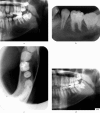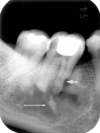Radiographic findings and prognosis of simple bone cysts of the jaws
- PMID: 20100916
- PMCID: PMC3520194
- DOI: 10.1259/dmfr/54872008
Radiographic findings and prognosis of simple bone cysts of the jaws
Abstract
Objective: The aim was to evaluate the possibility of radiographic prediction of the prognosis of simple bone cysts (SBCs) of the jaws.
Methods: The relationship between the radiographic findings and treatment outcome (healing or recurrence) was investigated in 31 cases treated in the authors' hospital and 108 published cases.
Results: In 17 of our 31 cases, the lesions had radiographic findings of a preserved lamina dura adjacent to the lesion, with a smooth margin, and no or smooth bone expansion, and all of them healed after surgery. In the other 14 cases, there was resorption of the lamina dura, a scalloped margin, nodular bone expansion, root resorption, a sclerotic mass or multiple cavities, and nine cases of recurrence. Although there was incomplete information in the published case studies, similar results were noted.
Conclusions: It was concluded that there was a relationship between the radiographic features of the lesions and prognosis. Radiographic examination should be used not only for discovering and diagnosing the lesions, but also for predicting possible prognosis.
Figures





Similar articles
-
Multiple simple bone cysts of the jaws: review of the literature and report of three cases.Oral Surg Oral Med Oral Pathol Oral Radiol. 2014 Jun;117(6):e458-69. doi: 10.1016/j.oooo.2014.03.004. Epub 2014 Mar 15. Oral Surg Oral Med Oral Pathol Oral Radiol. 2014. PMID: 24842451 Review.
-
[Differential diagnosis of cystic and cystic-like lesions of the jaw].Rofo. 1985 Aug;143(2):159-65. doi: 10.1055/s-2008-1052782. Rofo. 1985. PMID: 2992029 German.
-
Histopathologic and radiographic findings of the simple bone cyst.Oral Surg Oral Med Oral Pathol Oral Radiol Endod. 1998 May;85(5):619-25. doi: 10.1016/s1079-2104(98)90301-8. Oral Surg Oral Med Oral Pathol Oral Radiol Endod. 1998. PMID: 9619684
-
Aneurysmal bone cysts of the jaws.Int J Surg Pathol. 2009 Aug;17(4):311-22. doi: 10.1177/1066896909332115. Epub 2009 Feb 19. Int J Surg Pathol. 2009. PMID: 19233862 Review.
-
Rare, simultaneous, multiple, and recurrent mandibular bone cysts.Quintessence Int. 2008 Apr;39(4):331-6. Quintessence Int. 2008. PMID: 19081903
Cited by
-
Traumatic bone cyst of mandible: a case series.J Med Case Rep. 2019 Sep 18;13(1):300. doi: 10.1186/s13256-019-2220-7. J Med Case Rep. 2019. PMID: 31530284 Free PMC article. Review.
-
Solitary bone cyst.Head Neck Pathol. 2010 Sep;4(3):208-9. doi: 10.1007/s12105-010-0179-1. Epub 2010 Apr 20. Head Neck Pathol. 2010. PMID: 20405250 Free PMC article.
-
Asymptomatic Simple Bone Cysts Revealed by Imaging: A Report of Two Cases.Cureus. 2025 Jul 2;17(7):e87166. doi: 10.7759/cureus.87166. eCollection 2025 Jul. Cureus. 2025. PMID: 40755604 Free PMC article.
-
Clinical and radiographic features of solitary and cemento-osseous dysplasia-associated simple bone cysts.Dentomaxillofac Radiol. 2011 May;40(4):230-5. doi: 10.1259/dmfr/16355120. Dentomaxillofac Radiol. 2011. PMID: 21493879 Free PMC article.
-
Traumatic bone cyst of mandible.J Maxillofac Oral Surg. 2015 Jun;14(2):466-9. doi: 10.1007/s12663-010-0114-8. Epub 2010 Nov 25. J Maxillofac Oral Surg. 2015. PMID: 26028875 Free PMC article.
References
-
- Weber AL, Kaneda T, Scrivani SJ, Aziz S. Jaws and temporomandibular joints. In: Som PM, Curtin HD (eds). Head and neck imaging, 4th edn. St. Louis: Mosby, 2003, pp 942–943
-
- White SC, Pharoah MJ. Oral radiology principles and interpretation, 5th edn. St. Louis: Mosby, 2004, pp 405–409.
-
- Shafer WG, Hine MK, Levy BM. A textbook of oral pathology, 4th edn. Philadelphia: WB Saunders, 1983, pp 541–544.
-
- Damante JH, Da S, Guerra EN, Ferreira Jr O. Spontaneous resolution of simple bone cysts. Dentomaxillofac Radiol 2002;31:182–186 - PubMed
-
- Sapp JP, Stark ML. Self-healing traumatic bone cysts. Oral Surg Oral Med Oral Pathol 1990;69:597–602 - PubMed

